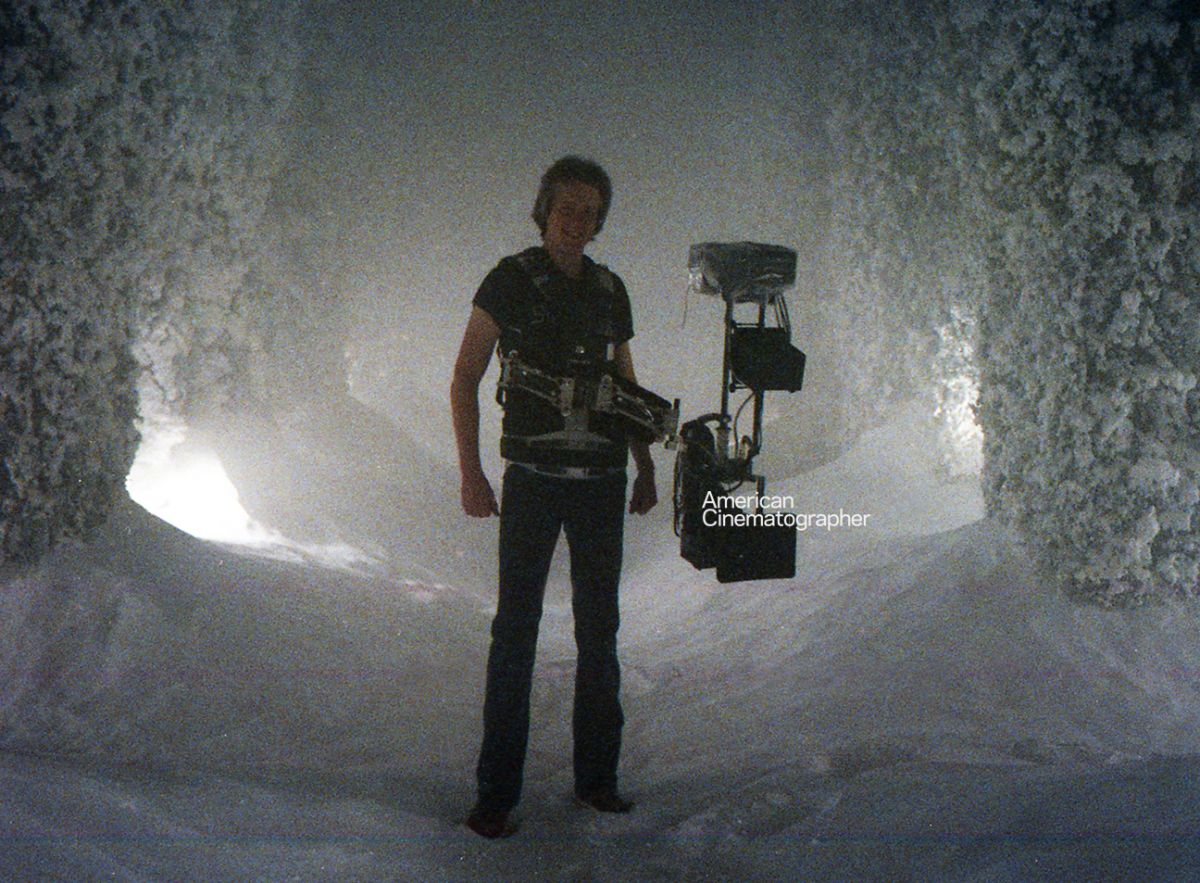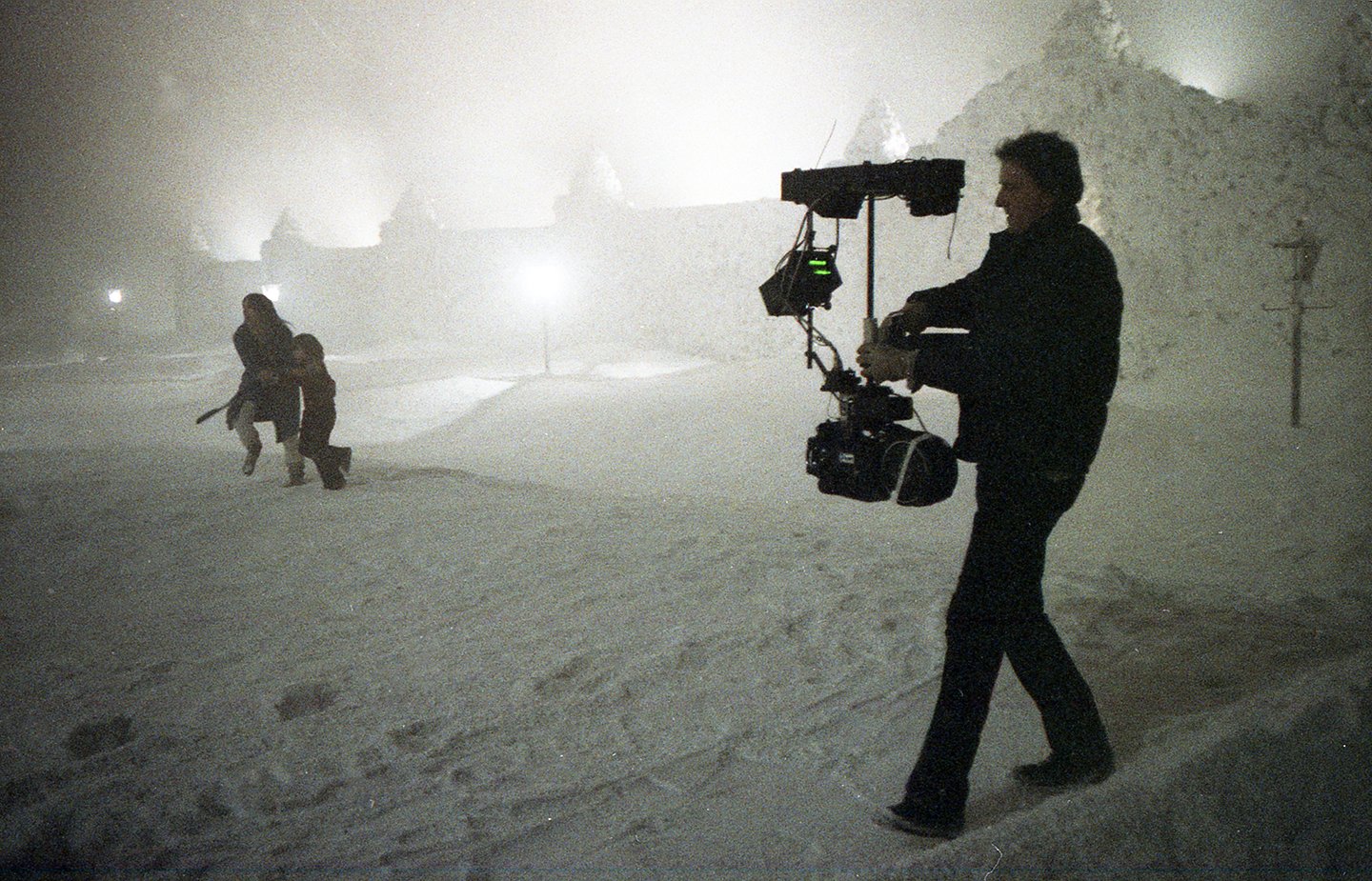
The Steadicam and The Shining Revisited
The Academy Award-winning camera stabilizer lent great fluid scope to Stanley Kubrick’s classic horror film.
(2022 Editor’s Note: What follows is the revised text of Steadicam inventor and ASC associate member Garrett Brown’s personal account of his time operating an early model of the Steadicam on Stanley Kubrick’s The Shining, originally published in the August 1980 issue of AC. It has been edited by Brown for clarity and to accommodate the inclusion of new color and black-and-white 35mm photographs provided by the author, except where noted. You can find our coverage of cinematographer John Alcott, BSC’s work on the film by clicking on the cover image below.)
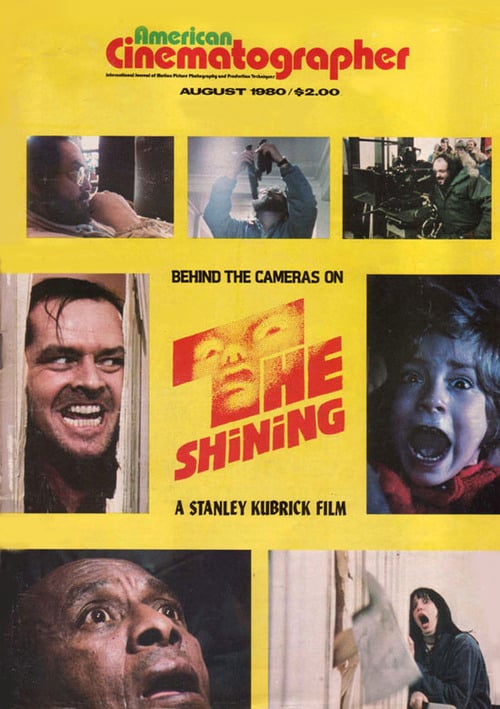
(1980 Editor’s Note: Garrett Brown and Cinema Products Corporation shared an Oscar in 1978 for the invention and development of Steadicam. Immediately after the ceremony, Brown left for London to begin work on The Shining.)
In 1974, Stanley Kubrick received a print of the 35mm demonstration film shot with the original prototype of what would later be called the “Steadicam.”
Kubrick’s telexed response [to Cinema Products head Ed DiGiulio] is reprinted below:
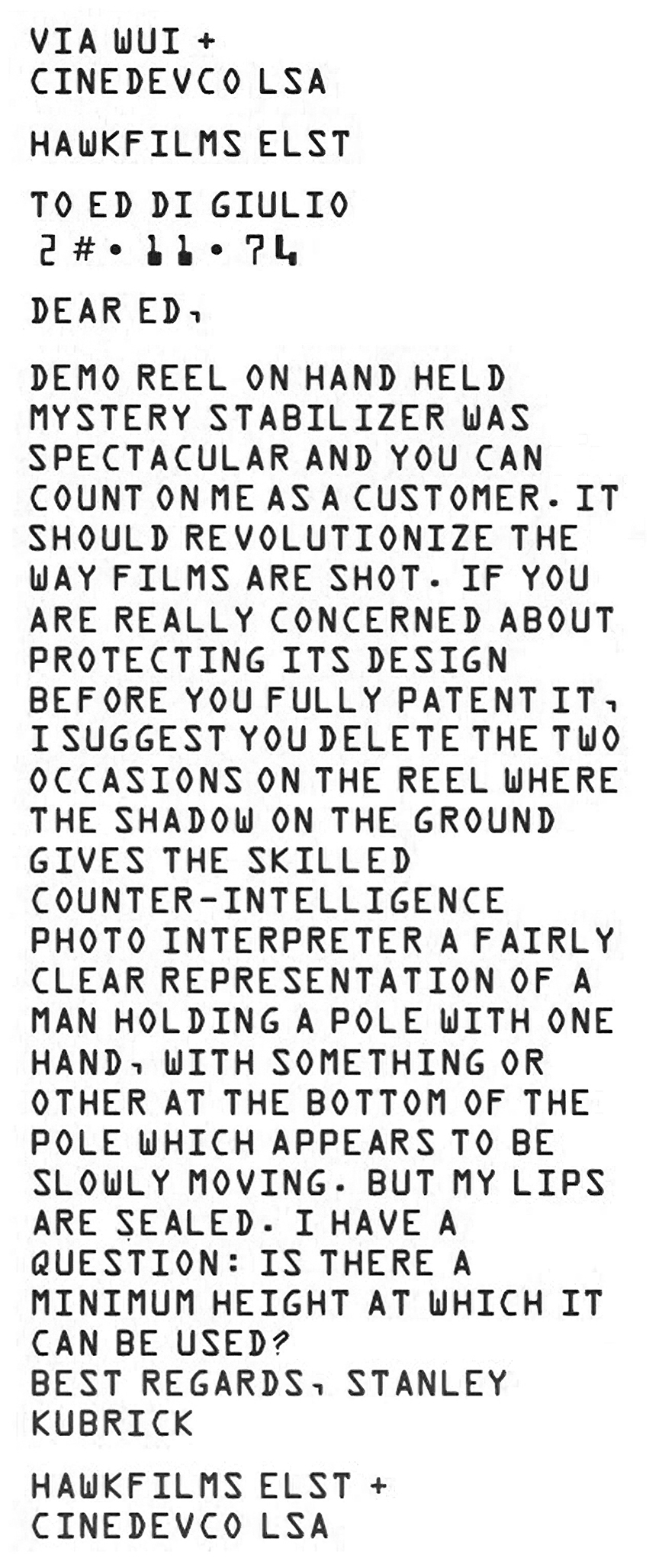
To date, it cannot be said with complete conviction that the Steadicam has revolutionized the way films are shot. [Author’s Note: My present self would say that, amazingly, it has!] However, the Steadicam had a considerable effect on the way The Shining was shot. Many of Kubrick’s tremendously convoluted sets were designed with the Steadicam's possibilities in mind and were not, therefore, necessarily provided with either flyaway walls or dolly-smooth floors. One set in particular, the giant Hedge Maze, could not have been photographed as Kubrick intended by any other means.
I worked on The Shining in England at the EMI Studios in Borehamwood for the better part of a year. I had daily opportunities to test the Steadicam and my operating against the most meticulous possible requirements as to framing accuracy, the ability to hit marks and precision repeatability. I began the picture with years of Steadicam use behind me and with the assumption that I could do with it whatever anyone could reasonably demand. I realized by the afternoon of the first day’s work that here was a whole new ball game, and that the word “reasonable” was not in Kubrick’s lexicon.
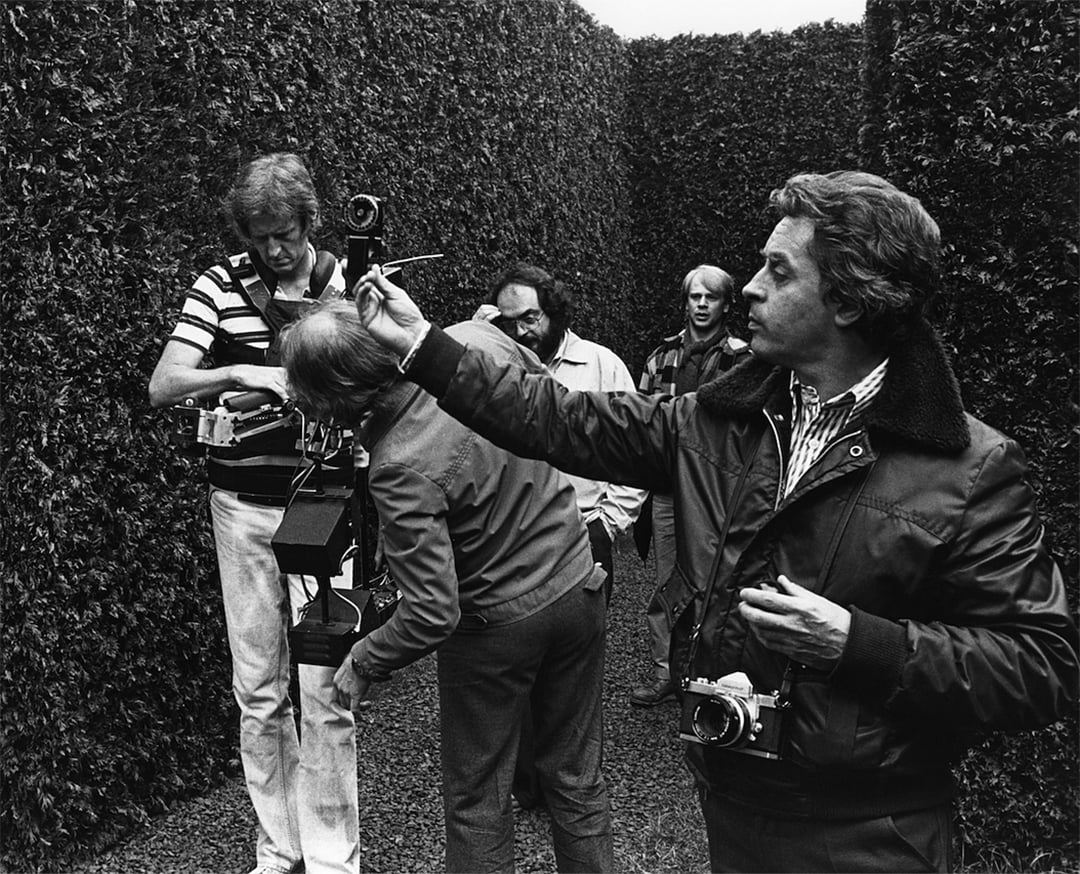
Opening day at the Steadicam Olympics consisted of 30-or-so takes of an elaborate traveling shot in the lobby set, interspersed with ballockings for the air-conditioning man (because it was 110 degrees in the artificial daylight produced by 700,000 watts of light outside the windows) and complaints about the quality of the remote TV image.
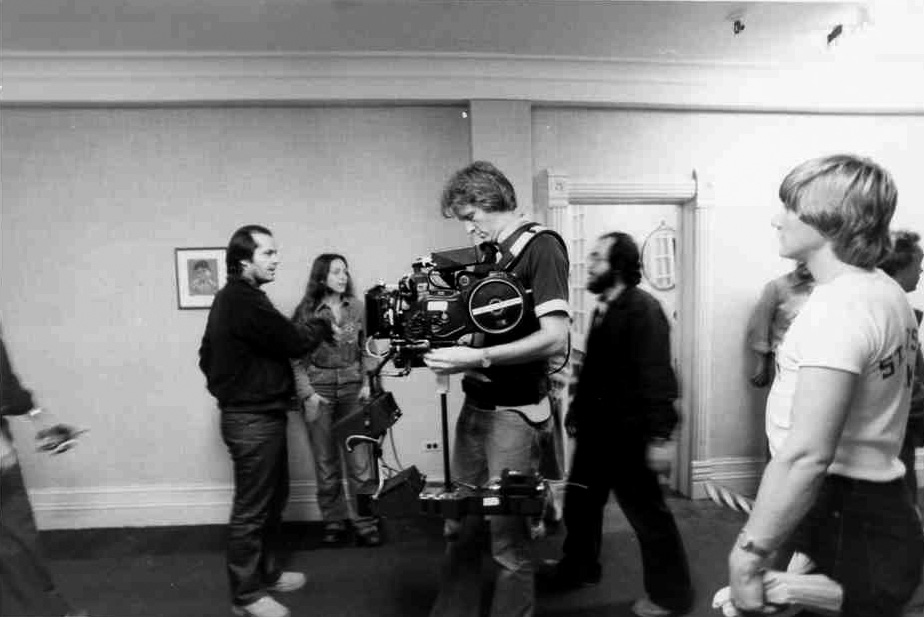
Although I had provided a crude video transmitter so that Kubrick could get an idea of the framing, I quickly realized that when Stanley said the crosshairs were to be on someone’s left nostril, that no other nostril would do. And I further realized that the crudeness of the transmitted image simply prolonged the arguments as to the location of the dread crosshairs. Had I known on that first day that we would still be debating questions of framing a year later, long after the air conditioning worked, I might have wished to become an air-conditioning man or a caterer...
SETS
I first met Stanley Kubrick during FILM 77 in London when Ed DiGiulio, president of Cinema Products Corporation, and I took the latest model out to Borehamwood to demonstrate it. At this time, The Shining was in its early preproduction stages. Stanley had engaged Roy Walker to design the sets, and we provided them with some food for thought by going over the various maneuvers that were then possible and, at Kubrick’s request, demonstrating the accuracy with which one could hit marks in order to pull focus in the neighborhood of T/1.4.
Throughout the following summer there were sporadic early morning phone calls from Kubrick and preliminary arrangements were made for my services, ostensibly to commence in December of 1978. In fact, the start date had been put back well into the spring when I was notified that I had won the Bert Easey Technical Award of the BSC. I decided to fly from Los Angeles to London to accept the award in person and to show Stanley some of our latest wrinkles. Cinema Products had just constructed the prototype of the new Universal II raised-monitor Steadicam and we had also devised the means to suspend the [Arriflex] 35BL from the Steadicam platform, thereby permitting a whole new range of lens heights from about 18 inches to waist-high. Kubrick seemed particularly pleased with the possibilities for low-lens shooting.
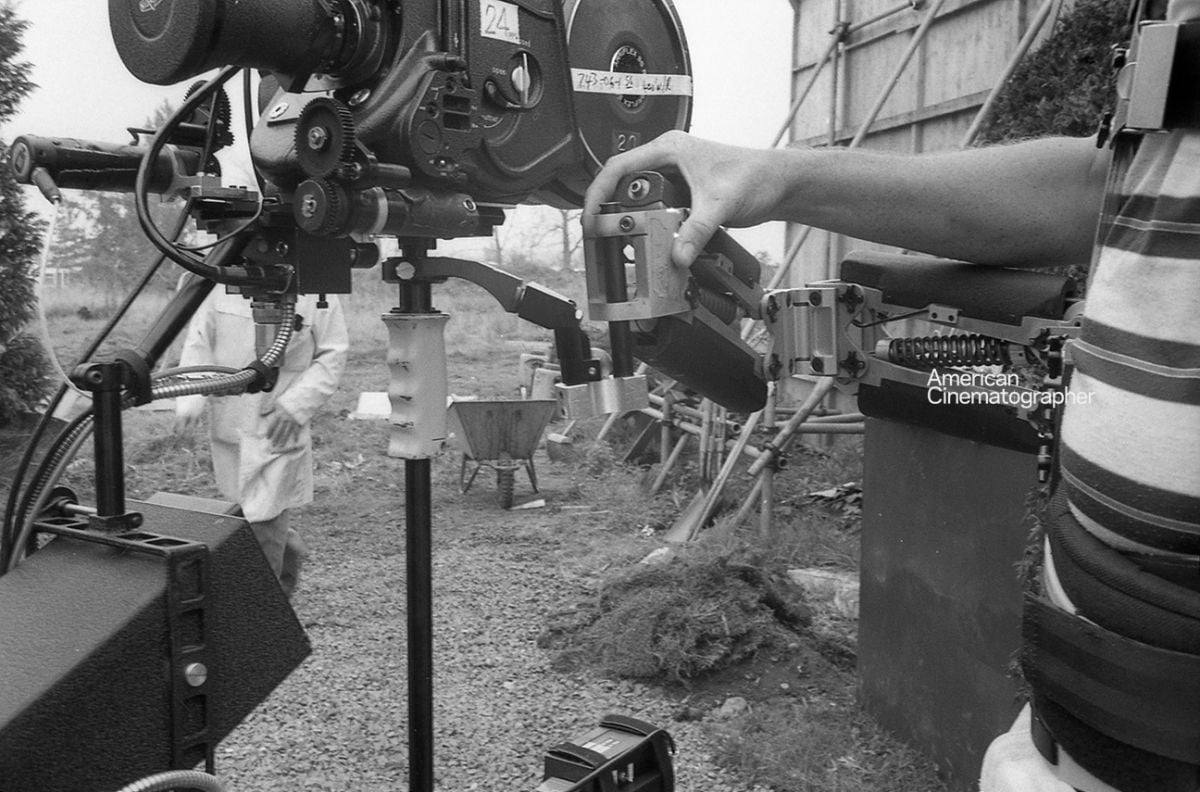
This time I was taken for a quick tour of the sets, including the monumental exterior set of the Overlook Hotel and the vast and intricate Colorado Lounge set with its interconnected corridors, stairs, and rooms on two levels. My excitement mounted as we progressed around corner after corner, each unexpected turn offering further possibilities for the Steadicam. Originally we had decided that I would rent some of the more exotic equipment to Kubrick and just come to England briefly to train an operator. However, as we continued, I became convinced that here was a unique opportunity for me. Kubrick wasn’t just talking of stunt shots and staircases. He would use the Steadicam as it was intended to be used — as a tool which can help get the lens where it’s wanted in space and time without the classic limitations of the dolly and crane.
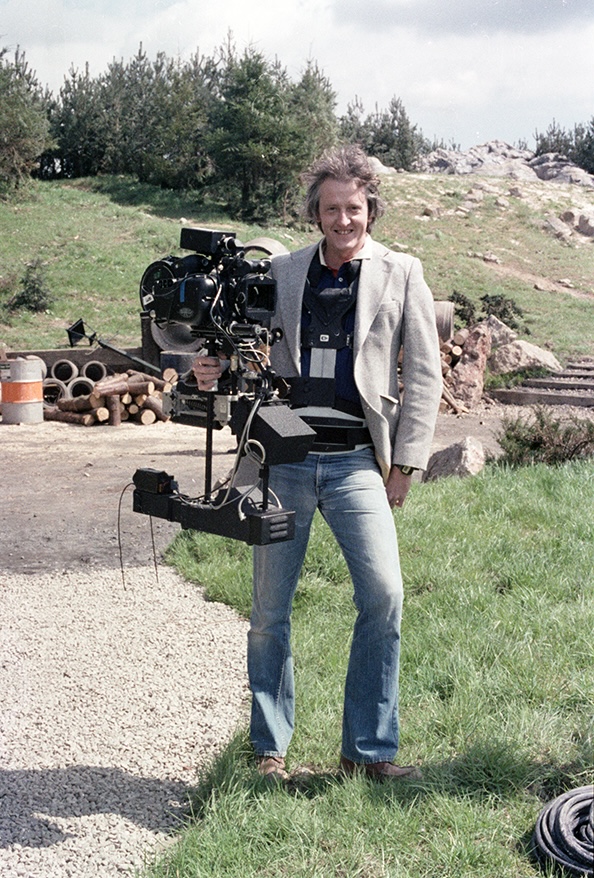
The kitchen set was enormous, with aisles winding between stoves and storage racks. The apartment sets were beautifully narrow. Suite 237 was elegant and ominous. The Overlook Hotel itself became a maze; absurdly oversized quarters for the players, yet ultimately claustrophobic. Here were fabulous sets for the moving camera; we could travel unobtrusively from space to space or lurk in the shadows with a menacing presence.
I guess I wanted to be there myself because Kubrick is the one director working who commands absolute authority over his project from conception to release print. The ultimate technologist, but more, his technology serves a larger vision which is uniquely his own. He is a filmmaker in the most pure sense of the word. I learned a great deal about the making of movies from simply being on hand for the stupefying number of discussions which sought to improve one aspect or another of the production.
PROGRESS
During the year of production which followed, the science of air-conditioning was reinvented and you can be certain that just about every other branch of human learning was at least reexamined insofar as it touched upon the doings in Borehamwood. Laboratory science, lighting, lenses, and the logistics of lunch — all were scrutinized daily. For example, the offending video transmitter was soon replaced by adapting Ron Collins’s AC-operated unit into a much smaller DC version (which has been a mainstay of my Steadicam services ever since). I was determined to remain unencumbered by wires, so the propagation of the signal became the next drama.
Although Stanley knows an astonishing amount about an astonishing number of things, his grasp of antenna theory is weak. He is, however, a formidable opponent in an argument — with or without the facts — so some bizarre theorems were actually tested and a disturbing number of them actually worked. By switching to various antennas hidden behind the walls, we were finally able to provide Stanley with acceptable remote wireless video nearly anywhere within his sets. To annoy him we would indicate the forest of TV antennas aimed at the studio from suburban Borehamwood and imply that the TV signal was escaping the sound stage and being watched by a gaggle of Monty Python women every morning:
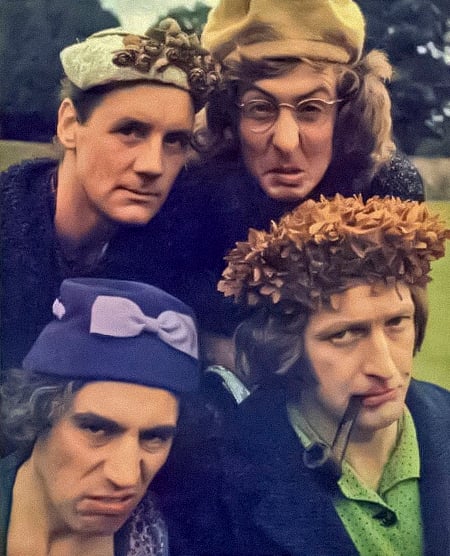
“Ooooh, poor Mr. Brown! .. That take seemed perfectly good to me!”
Somewhat later, our imitation ladies got even more sophisticated:
“Ooh, must be the 24mm Distagon!, see how it’s vignetting in the viewfinder!”
The infant science of the Steadicam advanced during the year. With the expert assistance of Mick Mason and Harold Payne of Elstree Camera Hire, we constructed a number of new mounts to adapt the Steadicam to various wheeled conveyances. After one ride on the converted skateboard and one push on the custom sackbarrel, both went into the “Bin of Whims” never to be seen again. However, Ron Ford’s elaborate motion-picture wheelchair proved more enduring. We made the first prototype of the Garfield Bracket to adapt the Steadicam arm to a Mitchell mount on the wheelchair. This was also useful on the Elemack and we later made use of the Elemack leveling-head on the wheelchair.
On the theory that one should ride whenever possible in order to concentrate on operating and forget navigating, I promoted every opportunity to use the chair. In a number of instances it was the only way to get the lens right down to floor level.
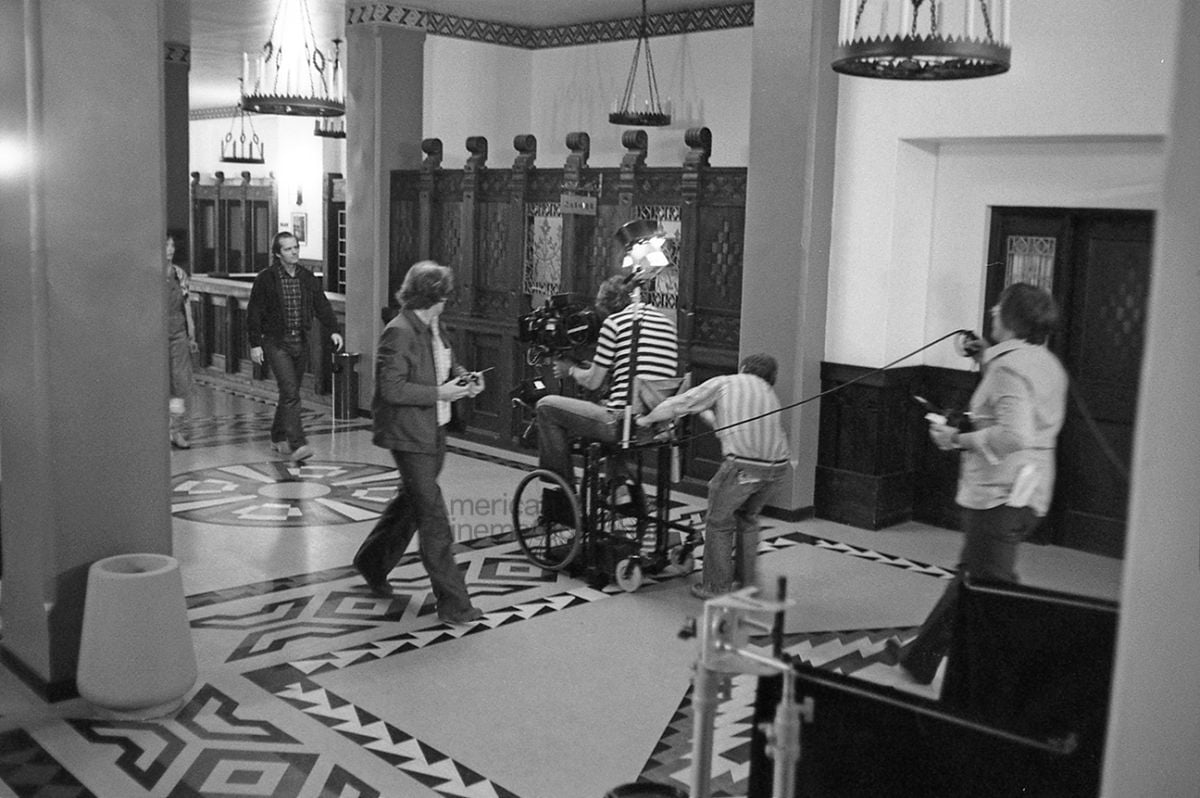
I think that useful progress was made in the area of operating technique. I had a chance to refine my own abilities in the most direct possible way. By repetition! (With playback!) Stanley made a number of useful observations and speculations about the interaction of the human body with machine such as this. Just how good can it possibly be? How close to the exact repeatability of a dolly shot? More than most filmmakers he knows the limitations of the dolly, and when it was necessary to have phenomenally good track, he rebuilt an entire 300' plywood roadway three times to get it smoother. During one difficult shot, Kubrick said gloomily that the Steadicam would probably get the credit for all the dolly moves in the picture anyway!
Although he would admit that I could produce a printable take by any reasonable standard within the first few tries, Stanley would seldom respond with anything but derision until about take 14. He did not appear to be comfortable until we were well beyond take 20. Since the editing was to occur entirely after the filming of the production, he wanted at least two and preferably three perfect takes on each scene. Basically this was fine with me. Although most retakes were for other reasons, I could see a gradual improvement in my operating with each playback. I learned the route like a dancer learns a difficult piece of choreography and I could relegate more and more of the navigating to my subconscious and attend to the rhythm of the shot. To be fair, Kubrick later admitted that in selecting takes he went for performance every time and that many were technically indistinguishable. (He has been known to mutter, upon sitting through 20 identical passes in the lunchtime screenings, "Damn crosshairs, they get me every time!")
THE “TWO-HANDED” TECHNIQUE
Throughout the production I worked on what we now call the “two-handed technique.” I found that if one hand strongly holds the Steadicam arm and is used to control its position and its height, the other hand is able to pan and tilt the handle with almost no unintentional motion in the shot. Whereas before the act of booming up or down would always seem to degrade slightly the steadiness of the image, now one can maintain the camera at any boom height and yet not influence the pan or tilt axis at all. This understanding has been the key to holding the beginning or end position of a shot so still that one must examine the frame line carefully in order to find any “float” at all. Kubrick was often able to use the head or tail of a Steadicam shot as his master for at least a portion of a dialogue scene.
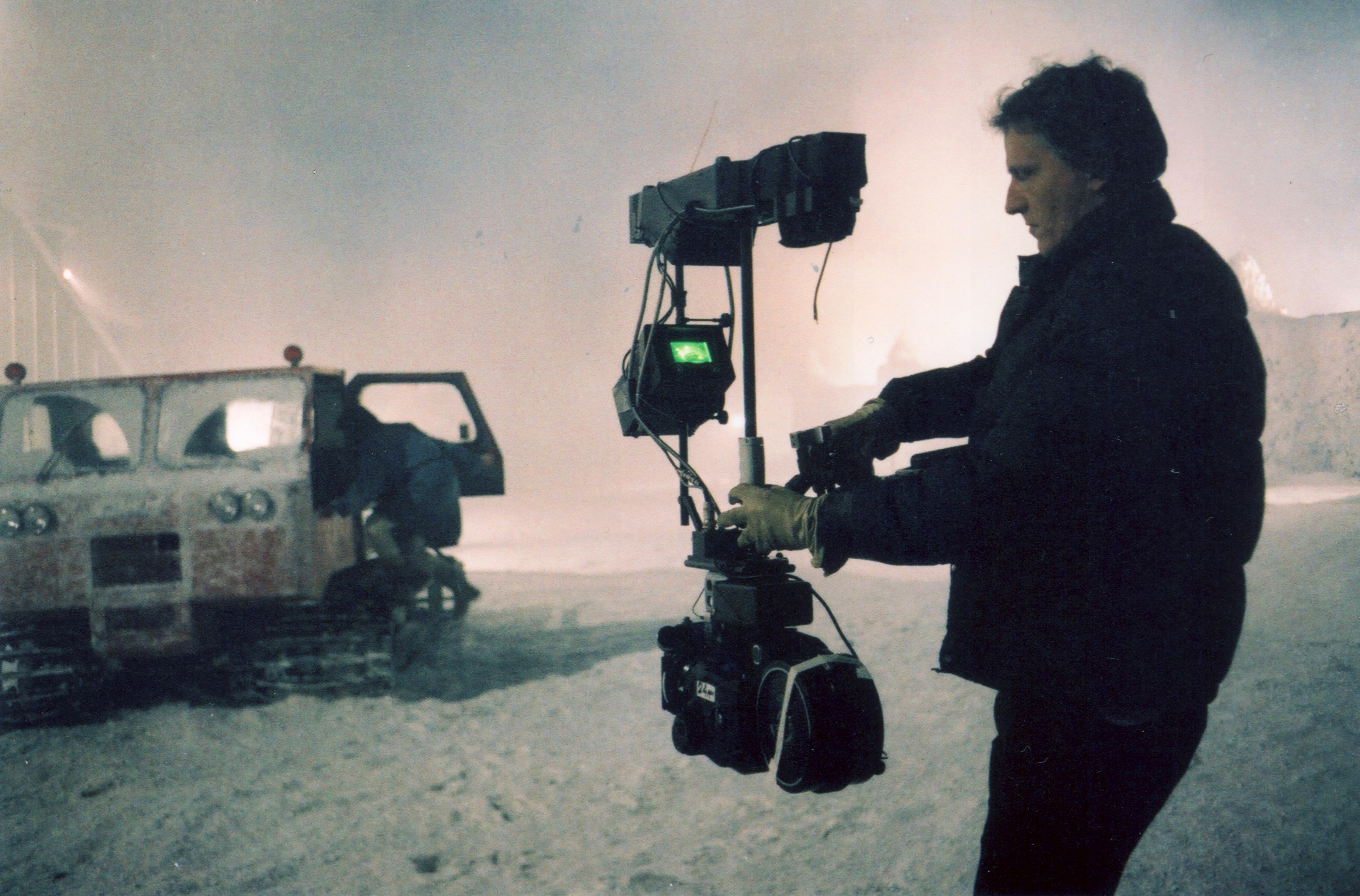
Even if I got caught in an awkward position because of an unexpectedly quick stop in the action Kubrick would count the beads of sweat, cast a practiced eye on the twitching of a calf muscle and wait until he judged that discs were about to fly like frisbees before he would quietly call “cut.”
THE 35BL
In the beginning I was somewhat apprehensive about shooting an entire picture with the 35BL on the Steadicam, not to mention that it was for Kubrick. It did not prove to be as difficult as expected. My style of operating is fairly relaxed anyway, and with the chance to put the camera down and watch a replay on each take, one could continue indefinitely or until the next tea and bacon-roll arrived. Bronx-born Stanley, not being so partial to such fare and eager to work through the evening break, had trayfuls of Big Macs delivered from the new McDonald’s nearby, much to the disgust of the English crew. (The BL does become somewhat more burdensome with a full cargo of hamburgers on board!)
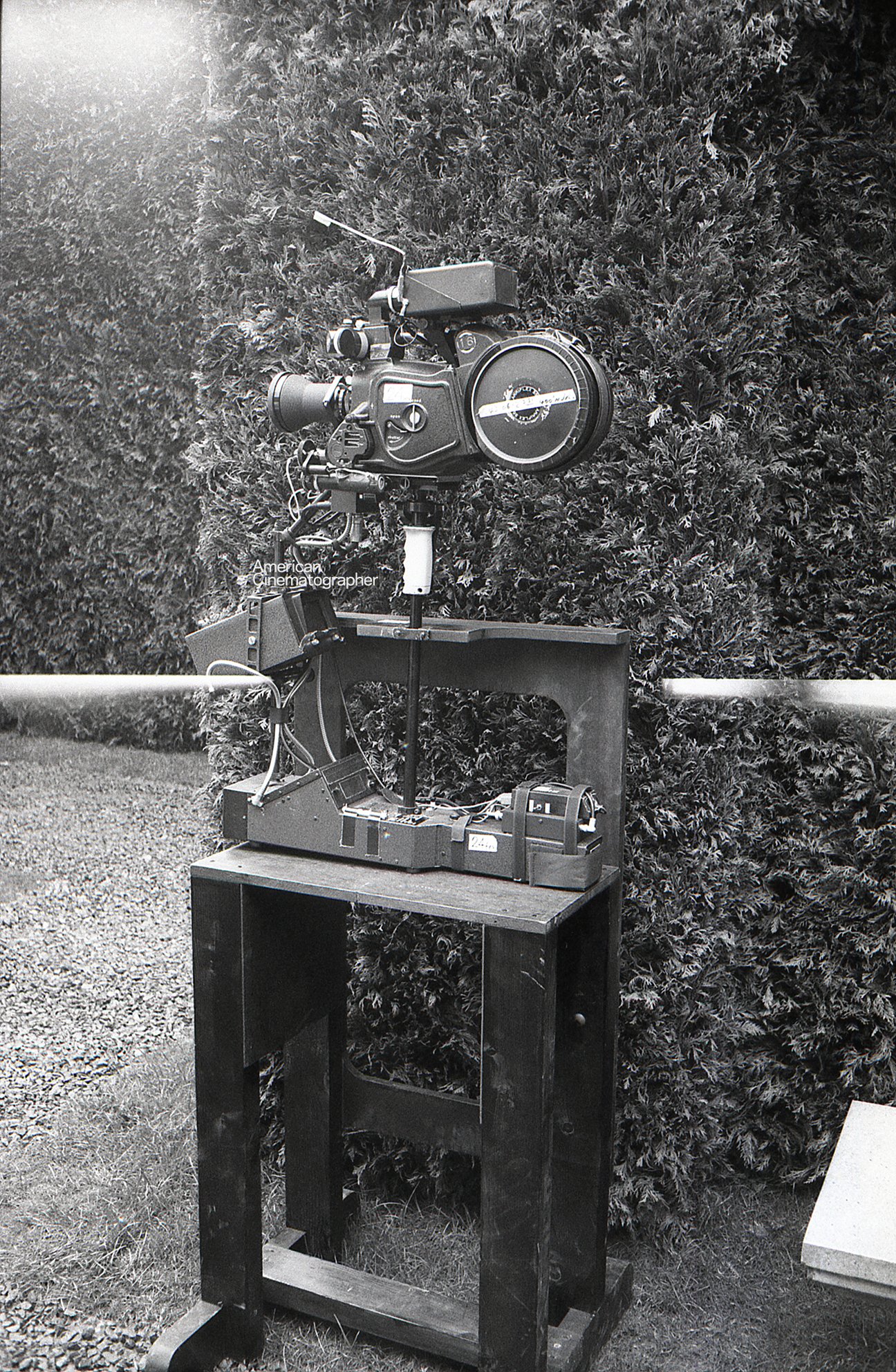
One advantage of the 35BL is its mass. It’s about 10 pounds heavier than the Arri IIc, but it allows a noticeably quieter frame. Also, the BL is less affected by gusts of wind. All in all, I came to prefer it to the Arri IIc for general shooting.
CLOSE QUARTERS
From the beginning, Kubrick intended to shoot within some of the more constricted sets without flying out walls as often as usual. Since he wished to use wide lenses, in particular the Cooke 18mm, he used the capability of the Steadicam to rapidly boom up and down to avoid distorting the sets. As someone approached and passed the camera we held the proper head-room by changing the height of the lens rather than tilting and risking the keystoning of the verticals on the set. Throughout the shooting I kept an additional spirit level mounted fore-and-aft on the Steadicam so that I could keep an eye on the tilt axis.
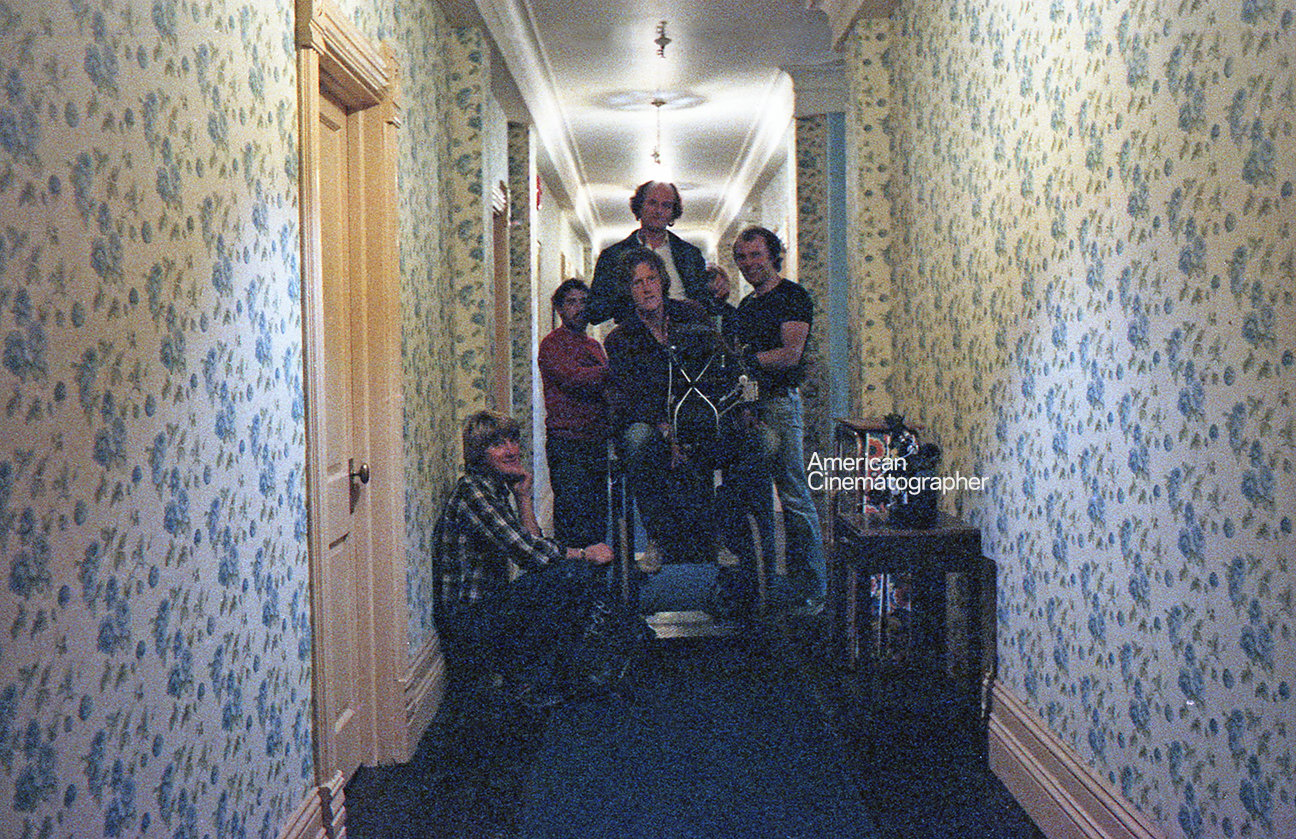
The Steadicam can reverse its direction rapidly and without any visible bump in the shot so one can back into a doorway or alcove and push out again as the actors pass by camera. In addition, since there are no geared-head handles in the way and no need for an operator's eye on the viewfinder, one can pass the camera within an inch of walls or door frames. The combination makes a formidable tool for shooting in tight location spaces. Of course, John Alcott was left with the lighting problems that result from this kind of freedom. However, I never heard him complain and he always managed to solve these difficulties in his usual imperturbable way. John personally flew in flags and dealt with some of the camera shadow problems that arise when you are seeing 360 degrees around a room.
My inaugural shot in the Torrance’s Boulder apartment gave Stanley some confidence regarding the Steadicam's future on The Shining. I had a shot bringing Wendy and the doctor back along the corridor from the bedroom, backing around in a curve, booming up, then way down as they sat on the sofa, finally holding still for 1/2 page of dialogue. There is nothing about this shot that would attract the undue attention of the audience, however the lens is just where Stanley wanted it throughout. This is exactly the kind of shooting that I am most interested in. I have an increasing reluctance to suggest to a director that I might be able to smoothly jump out of the window and land shooting. It may be a sign of getting older, or perhaps it just represents the maturing of my taste for the moving camera!
In the kitchen set, one of the best shots for the Steadicam in the picture involved backing up ahead of Scatman Crothers (Halloran, the chef), Shelley Duvall (Wendy) and Danny Lloyd (Danny) as the three take a winding path through rows of immense restaurant machines and huge stoves and racks of dishware. Even if there had been room to wheel a dolly along this path, the camera would have been required to stay more or less centered, which would have meant some very sudden pans as the camera’s axis swung around corners. In my case I took the least disturbing “line,” like a race driver going through turns, and so the result has an unearthly tranquility about it which seems to best fit the requirements of that particular scene. In short, with the Steadicam, one can choose to pivot on any axis: far ahead of the lens, the nodal point of the lens, the filmplane, or some point far aft of the camera. In the case of this shot, I was able to pivot my camera around an imaginary point halfway between me and the actors, and prevent violent swings from side-to-side as we made the turns.
In Jack and Wendy’s winter quarters in the Overlook, there were many spectacular opportunities for the Steadicam as the various players passed through the entrance hallway. For example, as we followed Wendy leaving the apartment, she would descend the three stairs just before the door and the camera would boom smoothly down in sync with her move. Then, as she passed through the door, I would boom up to negate the fact that I was now descending the same stairs, and then squeeze the matte box through the door just as it was closing. On several occasions I preceded Jack (Jack Nicholson) or Danny through the door and made the above maneuver in reverse. Obviously it is important that the camera doesn't make an unmotivated dip or rise just before or after the actor gets to the stairs. It feels better if the camera can be disembodied and not required to climb stairs itself! Other shots that stick in my mind: the-over-the shoulder on Jack as he climbs the stairs above the lobby to find Halloran, the very believable moving P.O.V.'s as Jack or Danny enter room 237.
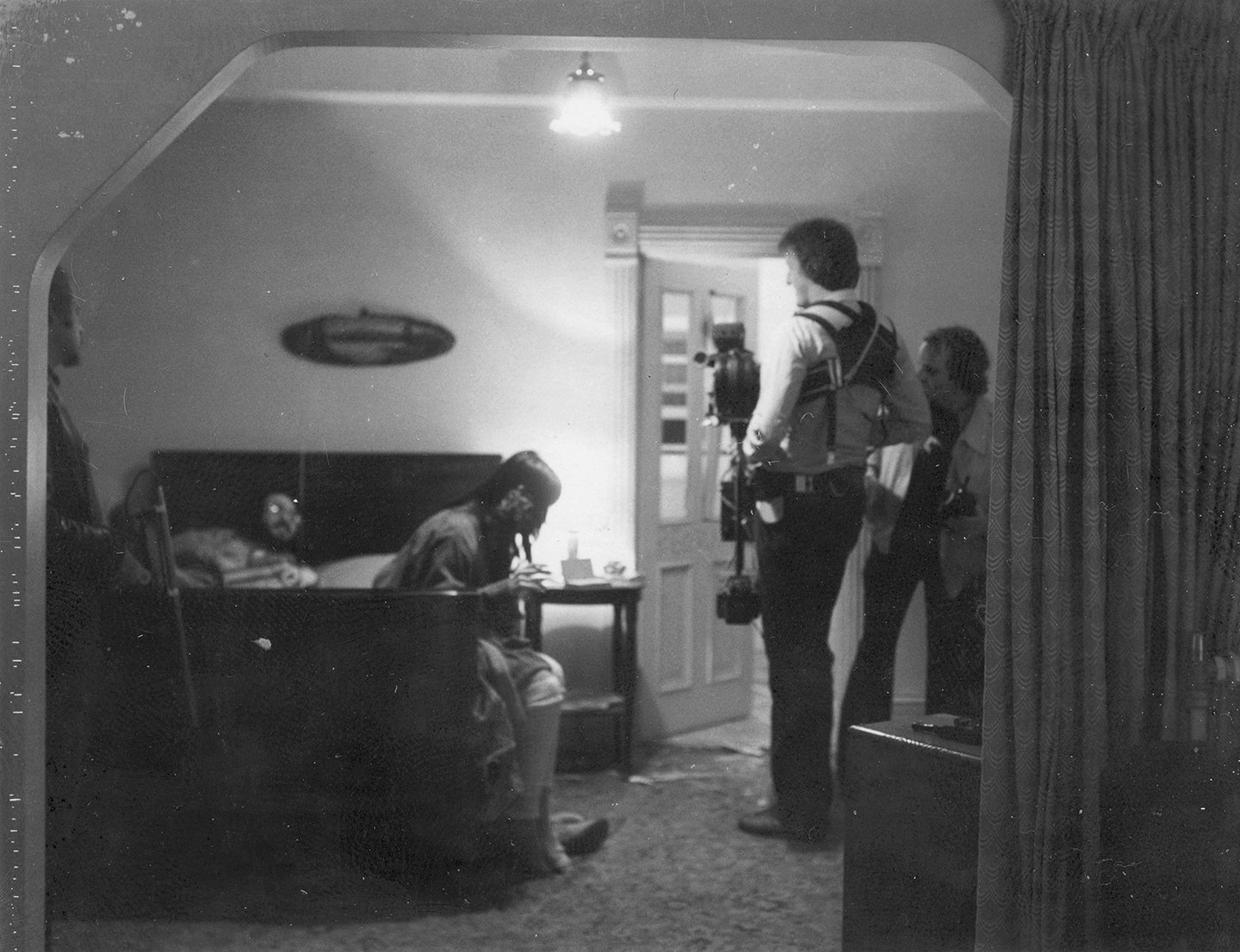
SPECIAL MOUNTS
One of the most talked-about shots in the picture is the eerie tracking sequence which follows Danny as he pedals at high speed through corridor after corridor on his plastic “Big Wheel.” The sound track explodes with noise when the wheel is on wooden flooring and is abruptly silent as it crosses over carpet. We needed to have the lens just a few inches from the floor and to travel rapidly just behind or ahead of the bike.
I tried it on foot and found that I was too winded after an entire three-minute take to even describe what sort of last rites I would prefer. Also, at those speeds I couldn’t get the lens much lower than about 18" from the floor. We decided to mount the Steadicam arm on the Ron Ford wheelchair prototype that Stanley helped design years before and still had on hand.
This is a very useful gadget. It can be properly steered in either direction with a simple set-up change, and the seat can be mounted low or high depending on the requirements of the shot. We arranged it so that rigging pipes could be fastened anywhere on the frame, and Dennis “Winkle” Lewis, our very able grip, constructed an adapter for the Elemack head. The Steadicam arm was fastened to the Mitchell mount, and I could sit on the chair and easily trim the leveling head to remove any imbalance in the “float” of the Steadicam.
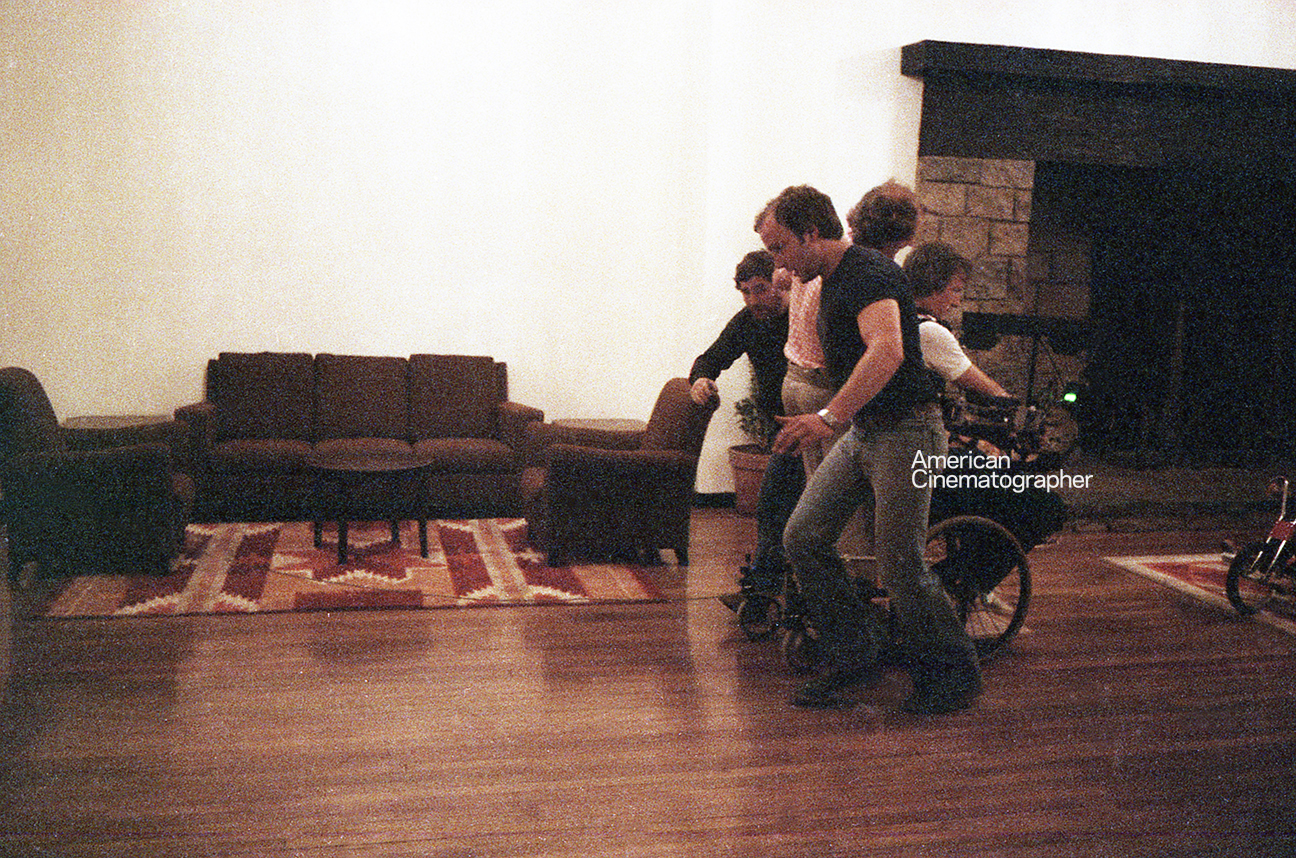
With Stanley’s BL in the underslung mode we were now prepared to fly the camera smoothly over carpet or floor at high speed and with a lens height of anything down to 1". The results, as can be seen, were spectacular. In addition, the whole rig wasn’t so massive that it would be dangerous if the little boy made a wrong turn and we had to stop suddenly. Of course, we immediately constructed a platform so that the sound man and our ace focus-puller, Doug Milsome, could ride on the back.
Now the entire contraption got to be quite difficult on the high speed corners. Dennis had to enlist relays of runners to get us around the course. Finally we had an explosive tire blow-out and the chair “plummered in,” barely avoiding a serious crash. Afterward we switched to solid tires and carried no more than two people.
Stanley contemplated this arrangement and decided that the chair should have a super-accurate speedometer, and while we’re at it so should the Moviola dolly and the Elemack. Then we could precisely repeat the speed of any traveling shot, etc. (More control over a capricious universe!) I was afraid that I would be lumbered with some kind of outboard wheel to precisely regulate my own speed, so I was happy that nothing came of this particular idea. (Although I would have enjoyed knowing how many miles I didn’t run because I had the wheelchair rig!)
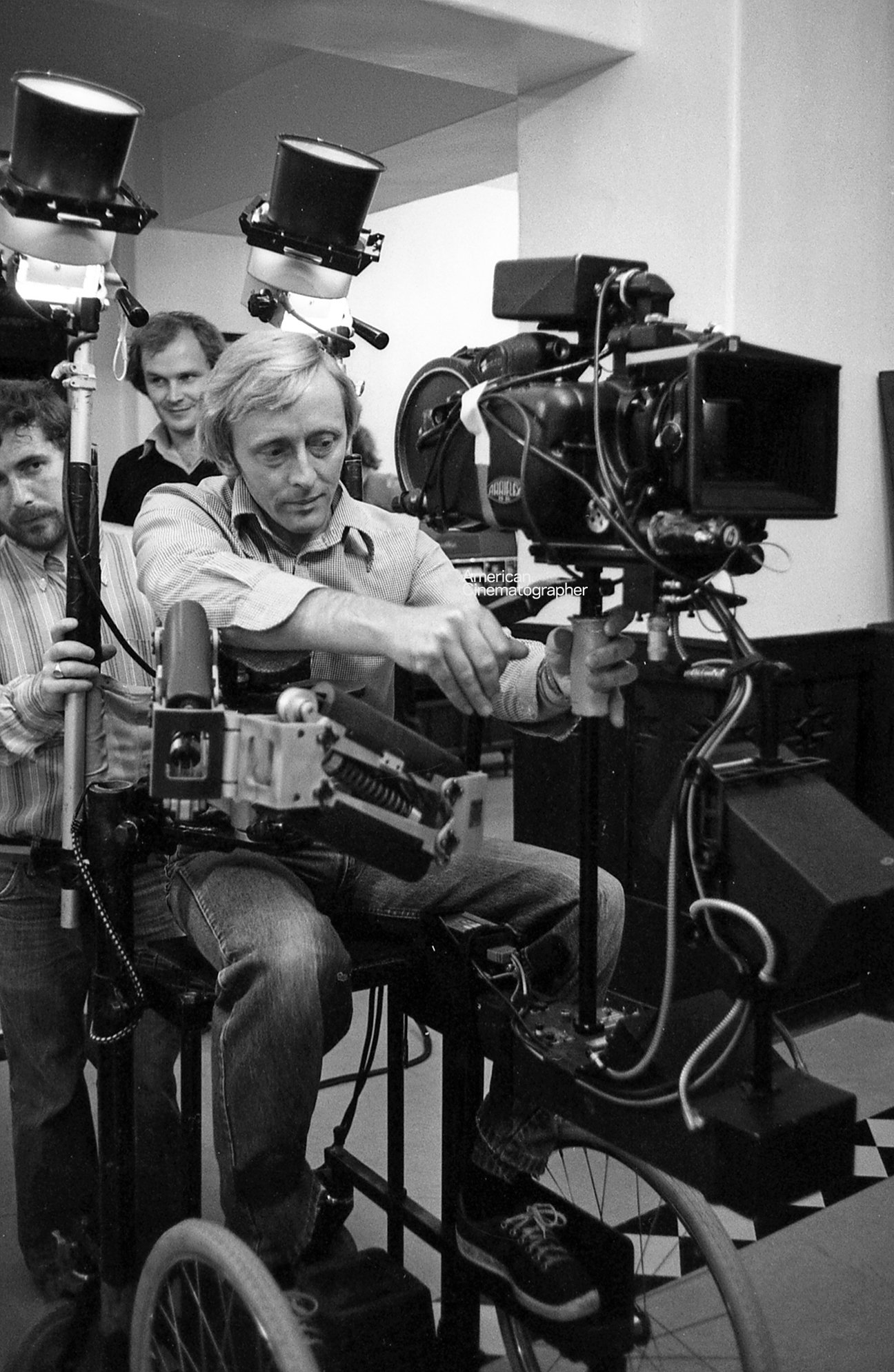
We used this set-up frequently in the weeks to come. In the fall I took a leave of absence for a month due to a prior commitment to shoot on Rocky II. An English operator named Ray Andrew very capably took over for me on this occasion and several others when I was required to commute back and forth from England to the U.S. Ray made a shot from the wheelchair in which the lens is one inch above the floor, moving slowly beside Jack’s head as he is being dragged toward the larder by Wendy. We also used the wheelchair with the lens at normal height to shoot a number of ordinary tracking shots through the corridors. The wheelchair was particularly useful when the camera had to move very slowly. If we needed to crab we mounted the arm on the Elemack dolly or the Moviola.
The operating technique in the chair also involves two hands: one for the arm, and one for the handle. You can easily jib over to the left and right, as well as boom up and down to compensate for slight variations in the course. We used this ability again to straighten out the camera’s path and cut corners in order to make these shots easier to watch. The only tricky aspect of shooting from the chair is that starts and stops tend to be dramatic. It is a little like carrying a full punch bowl in a decelerating rickshaw!
WIRELESS FOCUS AND IRIS PULLING
I brought to England the first prototype of Cinema Products’ sensational 3-channel wireless servo-lens-control, and Doug Milsome appeared to enjoy using it. He has a marvelous eye and something like a physicist’s knowledge of optics. I don’t think that we shot a soft frame in all the time I was on The Shining. He made up focus and iris strips on the servo-control for all the lenses. A surprising percentage of my shots on the picture involved iris pulls. We would commonly dial anything from 1/3 to 1½ stop changes and the results were undetectable on screen. Since we were often rushing through narrow spaces Milsome had to train his eye to pull focus from positions other than just abeam of the lens. We would get tangled in fantastic shifting choreographies and a wrong turn would find Doug outside the studio front gate, still gamely dialing the servo!
Kubrick has a fanatical concern for the sharpness of his negative. He resurrected the “harp test” for his lenses and then went beyond that to invent a bizarre variation on the harp test which positions one focus chart every inch for 15' out from the lens. The cameras were steady-tested nearly every week, and the dailies projectors (which belonged to Kubrick) were frequently torn down and rebuilt to cure unsteadiness due to wear. In addition, we shot with matte-perf film and our prints were made on the one and only captive printer at Rank that seemed to produce steady prints!
All this produced so much data that the results were subject at times to some confusion. The depth on one of the two BL units was packed by a few tenths on the theory that the film “liked” the image to bite somewhat into the emulsion. Lenses which were front-focused “preferred” one camera; back-focused lenses “preferred” the other, a master chart explained the feelings of each individual lens. It would be an exaggeration to say that I understood this system completely, but I must point out that I never saw sharper dailies, so the lenses obviously prefer the long-suffering Milsome as focus-puller.
THE MAZE
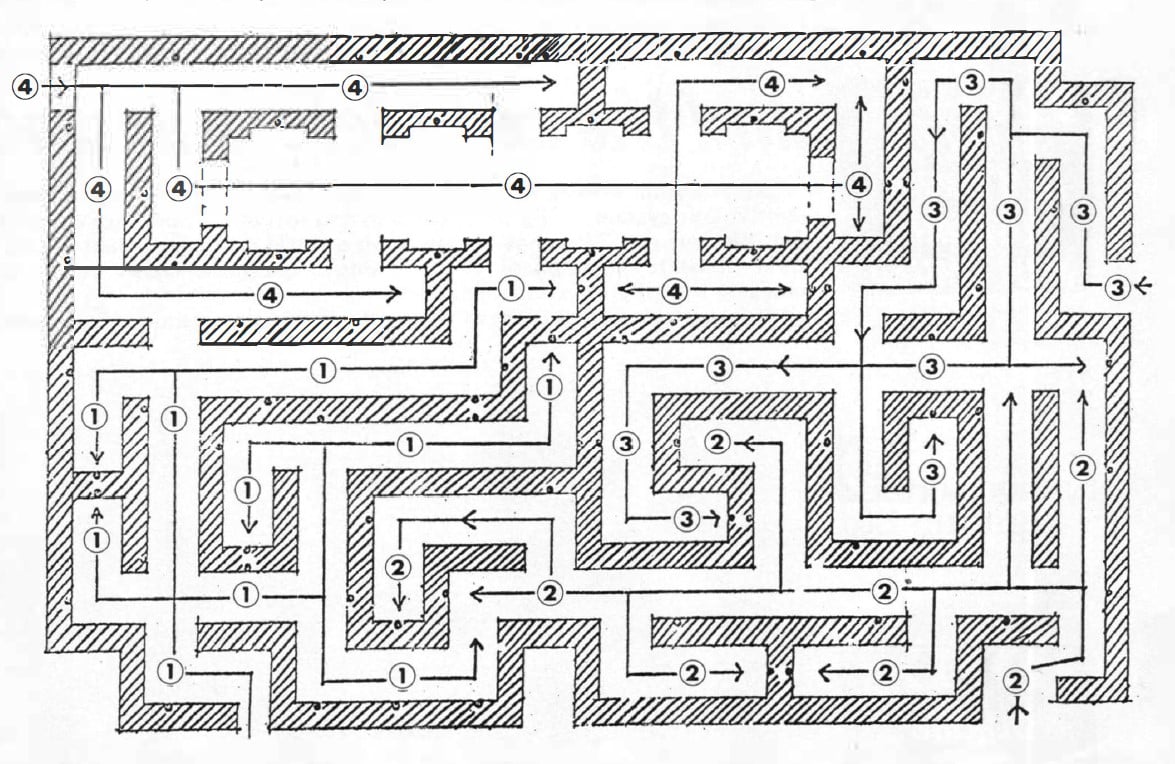
The giant Hedge Maze set must be one of the most intriguing creations in the history of motion pictures. It must also be one of the most pernicious sets ever to work on. And folks, every frame was shot with the Steadicam. In its benign “summer” form, the Maze was constructed on the old MGM lot outdoors at Borehamwood.
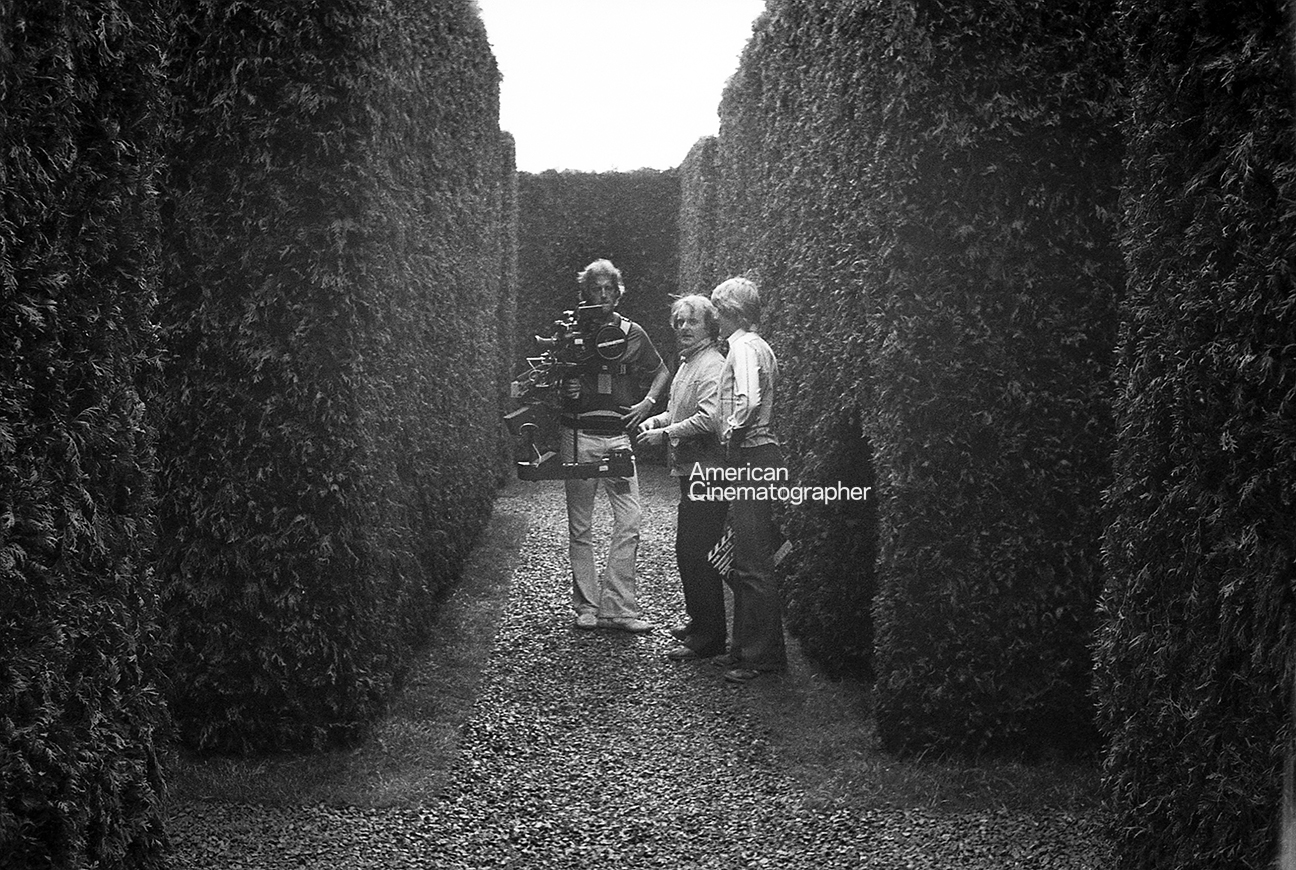
It was beautiful. The “hedges” consisted of pine boughs stapled to plywood forms. It was lined with gravel paths, and contained a center section (although built to one side of the set) which was wider than the rest. It was exceedingly difficult to find one's way in or out without reference to the map which accompanied each call sheet. Most of the crew got lost at various times and it wasn’t much use to call out “Stanley” as his laughter seemed to come from everywhere! It was amusing to be lost carrying nothing more than a walkie-talkie. It was positively hilarious if you happened to be wearing the Steadicam.

We determined by testing that the 9.8mm Kinoptik looked best, and that the ideal lens height was about 24". This combination permitted a tremendous sense of speed and gave the correct appearance of height to the walls. The distortion was negligible when the camera was held level fore-and-aft. Much of the shooting consisted of fluid moves ahead of or behind Wendy and Danny as they learn their way through the Maze. Some of the best moments came as we followed them right into a dead end and back out again in one whirling move. I also made some tripod-type shots in the center of the Maze since it would have been time-consuming to lug in the equipment to make a conventional shot.
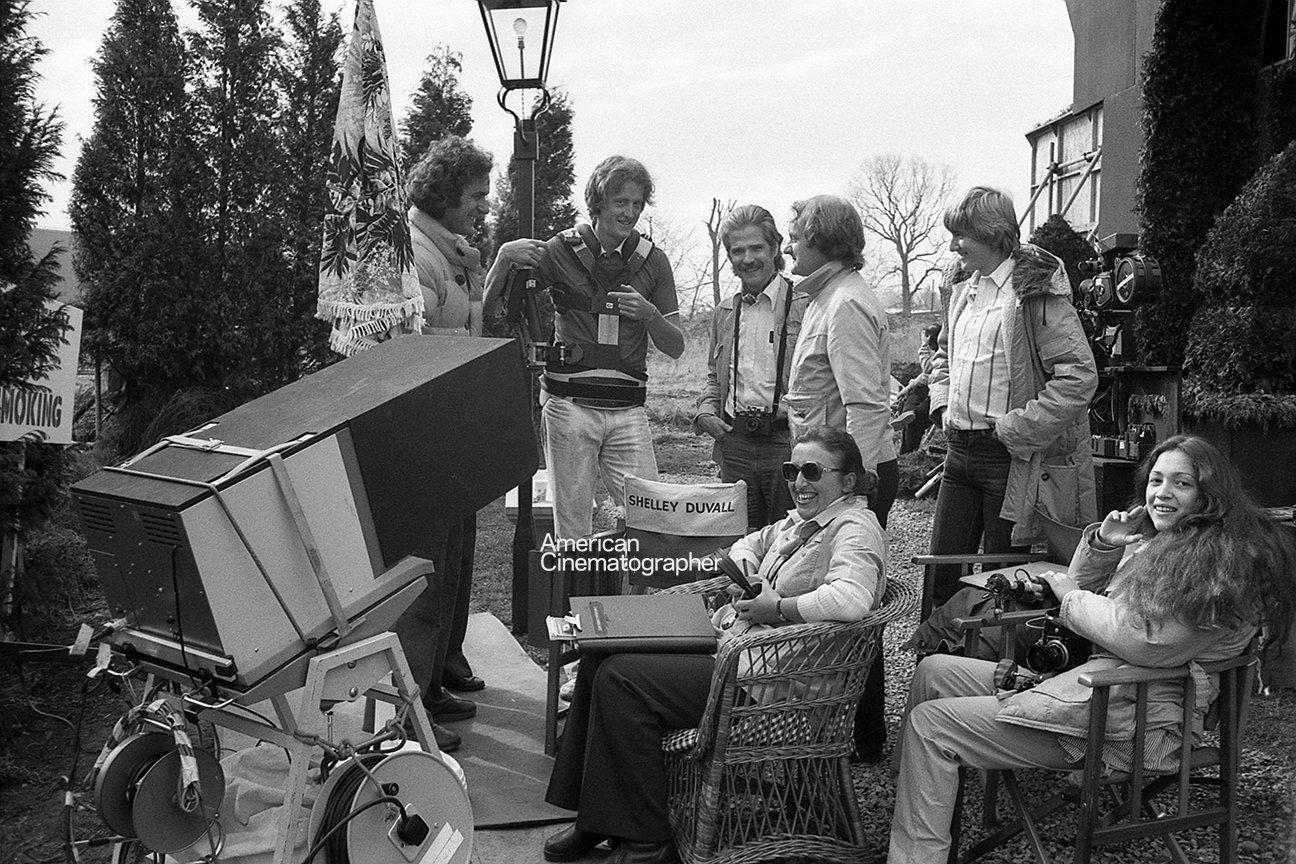
Stanley mostly remained seated at the video screen, and we sent a wireless image from my camera out to an antenna on a ladder and thence to the recorder. For the first time I found the ritual of playback a burden, since I had to walk all the way out of the Maze and back. We had made an early attempt to leave certain passages open to the outside. However, we found that we were constantly getting disoriented and a terrific shot would inadvertently wind up staring out one of the holes.
I discovered at this time that young Danny Lloyd weighed exactly as much as the camera, so we made a chair out of webbing and he would yell with delight as he swooped along riding suspended from the Steadicam arm. (I was sorry that I hadn’t thought of that one before my own son weighed as much as a BNC!
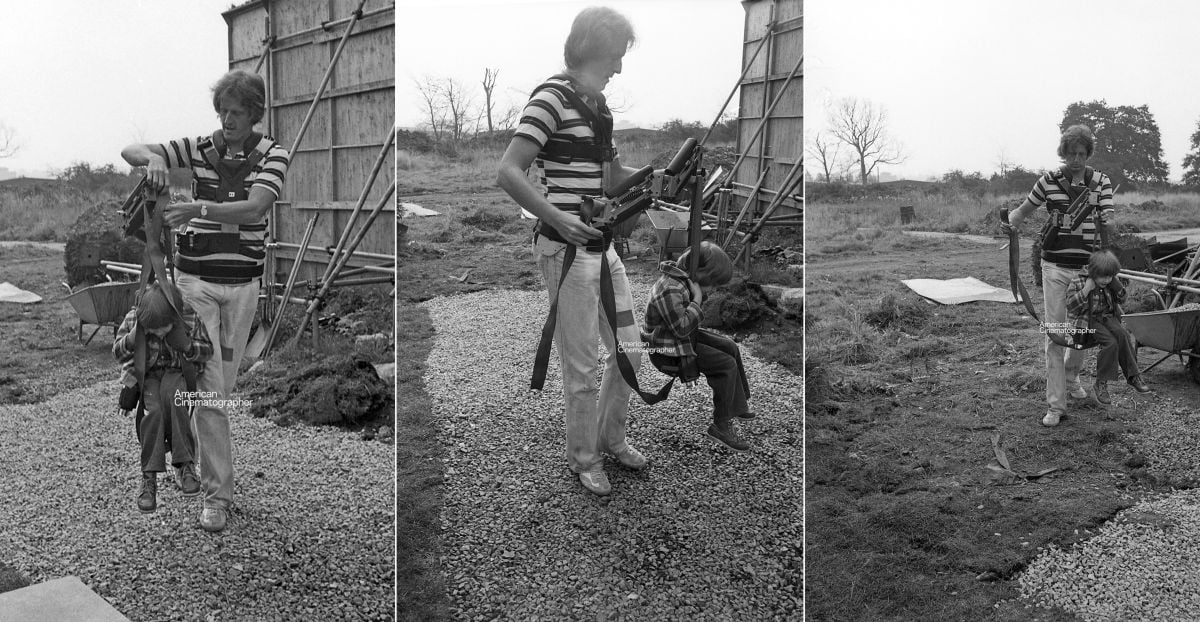
The Maze was then struck and re-erected on Stage 1 at the EMI Studios. Roy Walker’s men proceeded to “snow” it in with two feet of dendritic dairy salt and Styrofoam snow crusted on the pine boughs. The quartz outdoor-type lights were turned on and a dense oil-smoke atmosphere was pumped in for eight hours a day. Now the Maze became an unpleasant place in which to work. It was hot, corrosive and a difficult spot in which to breathe. The speed of the shots stepped up, since everything now happened at nearly a run. To lighten the load we switched to the Arri IIc from Joe Dunton Cameras and constructed a special underslung cage for it.
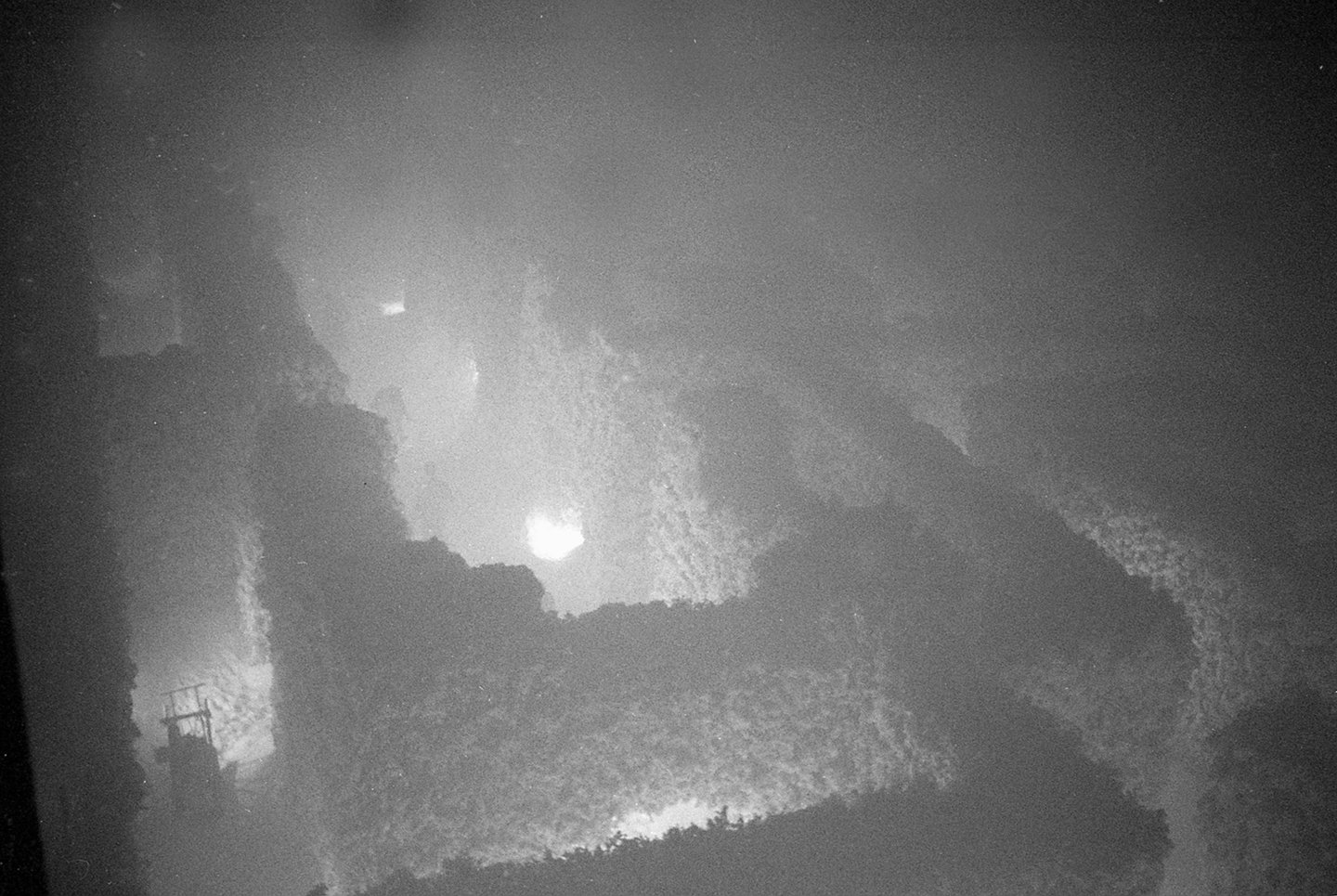
The “snow” was difficult to run on. I constantly had a fill light clattering around my legs, and I had to navigate by the sound of muffled curses ahead as the lighting and focus-pulling intrepids fell over one another in the salt. I think that the most difficult shots on the entire picture for me were the 50mm close-ups traveling ahead of Jack or Danny at high speed. Milsome deserves a lot of credit for keeping on his feet and keeping them sharp.
For a special shot of the boy’s running feet which required a lens height of three inches we made up a copy of my earliest Steadicam: no arm, just camera, battery and magazine, connected in a balanced arrangement so I could run along “hand-held” with the lens right on the deck.
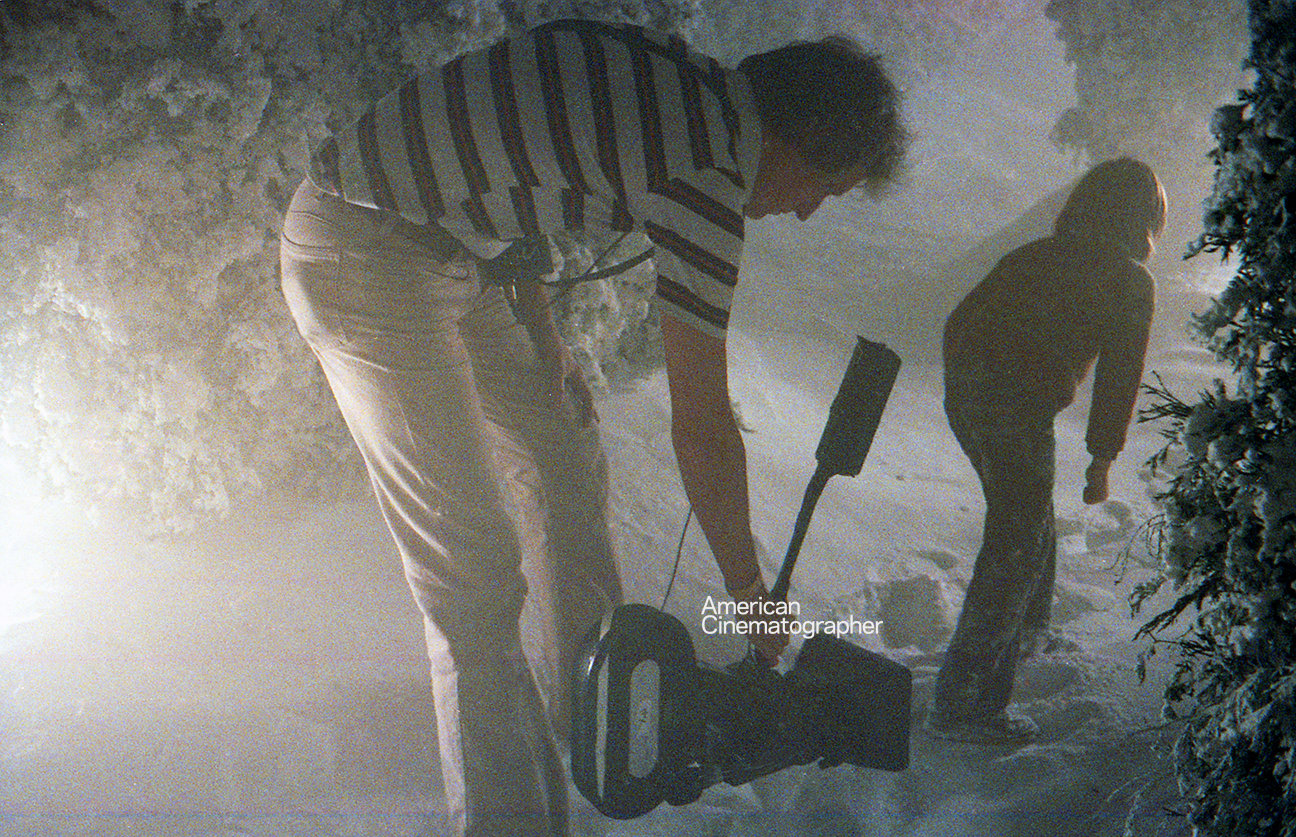
In the beginning we wore gas masks of various vintages. However, I found that I couldn’t get enough air to support the exertion of getting from one end of the Maze to the other. We never measured the linear distance from the entrance to the center, but I am sure it was a hell of a long way. This was the only time on the picture that I sometimes had to call a halt to the shooting until I could get enough breath to move again.
Stanley, meanwhile, watched the deteriorating video pictures from outside the set, like a wrathful Neilson family suddenly given absolute power over the programming. The faster we had to move, the worse it got. I sometimes thought wistfully of breaking an ankle in the salt. It required enormous force to pull the camera around the turns and a degree of luck to find the right path while essentially looking backward. In addition, we were all acutely aware of the danger of fire and how difficult it would be to get out of the maze if the lights went out, with real smoke and burning Styrofoam — a genuine nightmare!
The footage, however, looked sensational and the sequence is tremendous in the picture, so it is all, as they say, worthwhile. Some of the best stuff was slow-moving. As Danny backs up stepping in his own footprints to fool Jack, I had to back up ahead of him also in his footprints! To accomplish this I had to wear special boots with Danny-sized soles nailed to the bottom so I wouldn’t make the footprints any bigger!
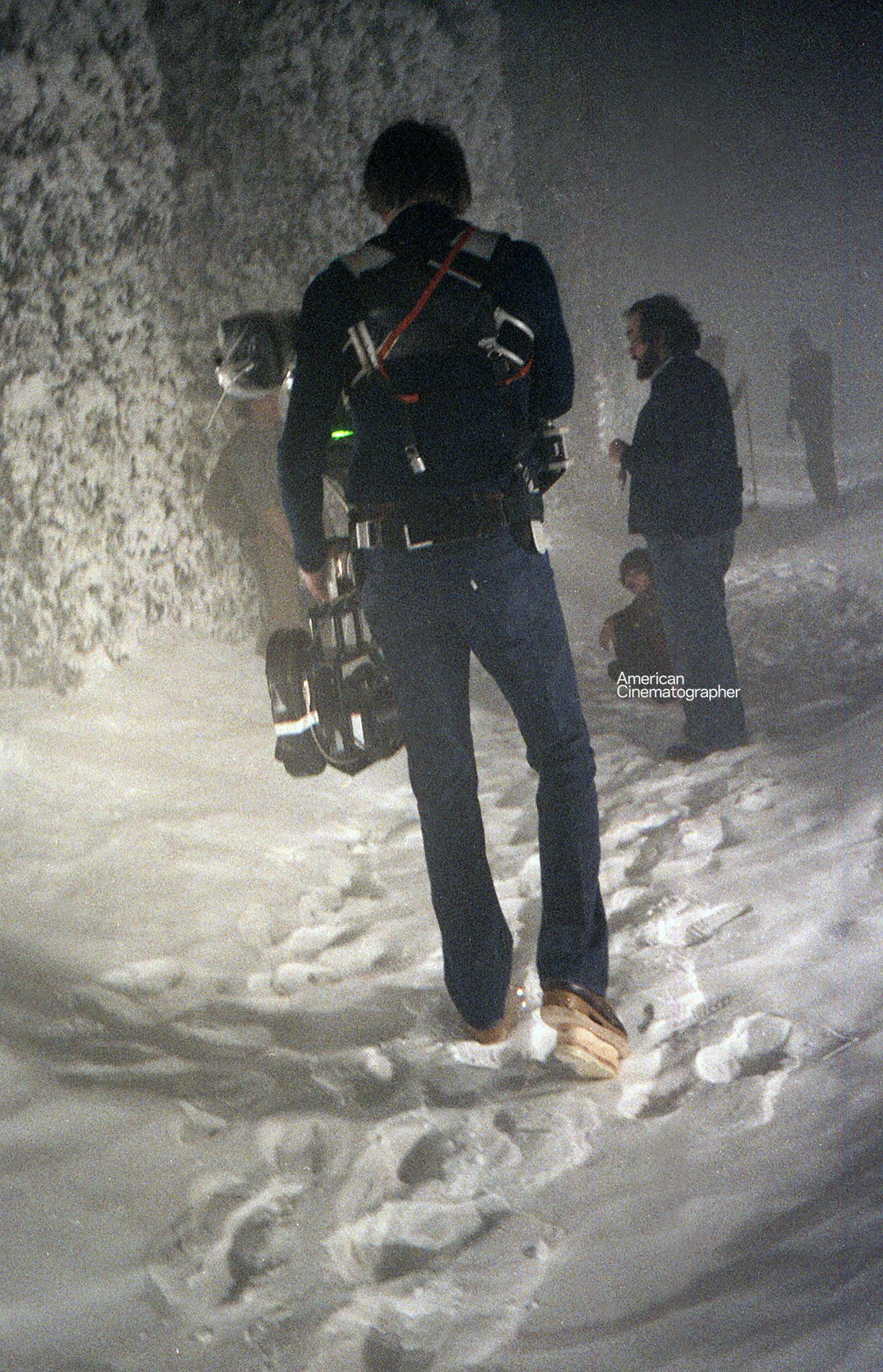
As it turned out, there were very few stair-climbing shots in the picture. Ray Andrew shot one which worked well as Wendy backs up the stairs swinging a baseball bat at Jack.
I made a “stairs” shot which is my all-time favorite. We are moving ahead of Wendy up three flights of stairs, starting rapidly, and smoothly slowing down until we are just barely moving ahead of her as she comes upon [the ghostly owner of the hotel] Harry Derwent and his strange doggy companion doing the unspeakable! A fabulous shot, despite the fact that we did it 36 times — multiplied by three flights equals climbing the Empire State Building with camera...
When I finally saw it on the silver screen I was glad to have made the climb, if for no other reason than...
“Because it was there!”
Brown later became an associate member of the ASC. We thank him for revisiting this story and supplying a number of rare or previously unseen production images.
Douglas Milsome continued to pursue his craft and was the director of photography on Kubrick’s Full Metal Jacket (1987), among many other pictures. He later became an active member of both the ASC and BSC.
If you enjoy archival and retrospective articles on classic and influential films, you'll find more AC historical coverage here.
